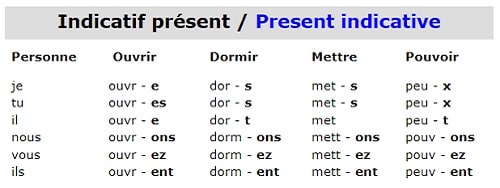TEXT IN FRENCH
CONJUGAISON : PRÉSENT
PROFESSEUR:
Bonjour, dans cet épisode de Learn French at ease nous allons parler du temps présent. On commence!
TITRE : QUAND EMPLOYER LE PRÉSENT?
PROFESSEUR:
En français, on utilise le présent pour parler d’une action ou situation qui se déroule au moment où nous nous exprimons.
Exemples :
Je pars à l’école.
il fait le ménage.
pour parler d’une action qui se déroule dans le présent ou situation présente.
Par exemple: Je m’appelle Tim. J’ai 24 ans.
pour parler d’une action ou situation en cours.
Par exemple: Je joue de la musique depuis 3 ans. C’est-à-dire, je continue à le faire.
On peut l’utiliser pour exprimer une vérité scientifique ou un fait habituel.
Par exemple : L’eau est la source de vie.
Le présent est aussi employé pour parler du futur.
Par exemple: La semaine prochaine, j’ai un examen.
TITRE : CONJUGAISON AU PRÉSENT
PROFESSEUR:
Pour conjuguer les verbes au présent, on remplace la terminaison de l’infinitif, selon le groupe du verbe, par les terminaisons suivantes :
Les verbes du premier groupe sont tous réguliers et leur infinitif se termine par -er (sauf pour le verbe aller qui est irrégulier et appartient au troisième groupe). Ce groupe représente près de 90 % des verbes.
Par exemple: parler
Tu parles (-es)
Il / Elle/ On parle (-e)
Nous parlons (-ons)
Vous parlez (-ez)
Ils / Elles parlent (-ent)
Les verbes du deuxième groupe se terminent par ir.
Par exemple: finir
Tu finis (-is)
Il / Elle / On finit (-it)
Nous finissons (-issons)
Vous finissez (-issez)
Ils / Elles finissent (-issent)
Attention : tous les verbes en -ir ne sont pas des verbes du deuxième groupe. Les verbes suivants appartiennent au troisième groupe :
mourir, partir, mentir, sortir, etc.
Les verbes du troisième groupe sont tous irréguliers. On peut cependant subdiviser ce groupe en trois sous-groupes :
1. Les verbes terminés en -IR (comme OUVRIR)
2. Les verbes terminés en -OIR (comme POUVOIR)
3. Les verbes terminés en -RE (comme METTRE)

TEXT IN ENGLISH
TEACHER:
Hello, in this episode of Learn French at ease we are going to talk about the present tense. Let’s start!
TITLE : WHEN TO USE THE PRESENT TENSE?
TEACHER:
In French, we use the present tense to talk about an action or situation that is happening at the moment we are speaking.
Examples :
I’m going to school.
He is cleaning the house.
to talk about an action that is taking place in the present or present situation.
For example: My name is Tim. I am 24 years old.
to talk about an action or situation in the present.
For example: I have been playing music for 3 years. That is, I’m still doing it.
It can be used to express a scientific truth or a common fact.
For example : Water is the source of life.
The present tense is also used to talk about the future.
For example: Next week I have an exam.
TITLE : FORMATION OF THE PRESENT TENSE
TEACHER :
To conjugate verbs in the present tense, we replace the infinitive ending, depending on the group of the verb, with the following endings:
The verbs of the first group are all regular and their infinitive ends with -er (except for the verb to go which is irregular and belongs to the third group). This group represents almost 90% of verbs.
For example: to speak (parler)
You speak
He / She speaks
We speak
You speak
They speak
The second group of verbs end with ir.
For example: to finish (finir)
You finish
He / She finishes
We finish
You finish
They finish
Attention: not all verbs with -ir are from the second group. The following verbs belong to the third group:
To die (mourir), To leave (partir), To lie (mentir), To go out (sortir), etc.
The verbs in the third group are all irregular. However, this group can be divided into three subgroups:
1. Verbs ending with -IR (like OUVRIR / DORMIR) – to open/ to sleep
2. Verbs ending with -OIR (such as POUVOIR) – can / to be able
3. Verbs ending with -RE (like METTRE) – to put

